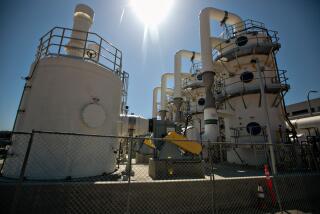Bacteria seem to be doing a good cleanup job in gulf
- Share via
As efforts continue to clean the oil that gushed from the blown-out well in the Gulf of Mexico, a team of scientists has found that nature’s microbial helpers are hard at work too — and doing a better job than researchers had expected.
Data collected in May and June showed populations of carbon-eating bacteria were increasing in parts of a plume of oil drifting in deep water in the gulf, said lead author Terry Hazen, head of Lawrence Berkeley National Laboratory’s ecology department.
“Within the last few weeks we’ve gone back and can find bacteria … but do not see detectable oil,” Hazen said. The most likely reason, he added, is that the voracious bugs ate it.
Now, he said, “since they no longer have the oil, they’re eating their [dead] brethren.”
The study, published online Tuesday in the journal Science, examined the deep-sea plume of oil 3,600 feet below the surface and up to six miles from the leaking wellhead. The scientists scooped seawater from different points within the plume as well as outside of it.
They assessed the mass of bacteria in their samples several ways: by counting cells under microscopes; measuring how much oxygen was depleted from the water, a sign of active microbial life; and by measuringchemicals called phospholipids (found in bacterial cell membranes).
The researchers also used DNA analysis to identify the types of bacteria they found.
Bacterial populations were low outside the plume, Hazen said, but were 100 times denser in oily areas. Within those prospering colonies, the bacteria that dominated were bugs that had genes for consuming oil.
The DNA of one particular carbon-eater — closely related to a group of bacteria called Oceanospirillales — was found in just 5% of the bugs in a control sample of unpolluted seawater, but more than 90% of the plume-dwelling populations.
Before the experiment was over it was clear the bacteria were prodigious oil-eaters, Hazen said. Even though the team sent seawater samples for analysis as fast as they could — Fed-Exing the bottled bacteria in ice-stuffed coolers —bacteria in some samples managed to munch through all the oil before they got to the lab.
But though it would be heartening to think that the bacteria had digested all the oil, Richard Camilli, an oceanographer at Woods Hole Oceanographic Institution in Massachusetts, said it was also possible that that the oil plume had moved or diluted to a point beyond detection.
“It becomes more difficult to find the plume after you’ve turned off the source,” said Camilli, who led a study published last week in Science that found the oil plume was 22 miles long when it was mapped in June. He compared it to “a train that’s leaving the station.”
Camilli said the new study showed the bacteria weren’t severely depleting the oxygen in the water. Thus, they were unlikely to create any “dead zones” — ocean regions where marine life cannot flourish — around the gulf’s fisheries.
But the study also showed the bacteria preferred to eat certain hydrocarbons in the oil — short-chain alkanes — over others. This suggested that long-chain molecules, including some of the more damaging hydrocarbons, would not disappear as quickly, Camilli said.
Hazen said he hoped to use the bacteria as a sort of tracking device for hard-to-spot or sporadically dripping oil leaks. But it’s not that simple: Even after the oil is consumed, oil-eating bacteria will continue to grow in the spot, feeding on the carbon-rich carcasses of fellow bacteria that lived, ate and died before them.
Understanding how long it takes for the population to settle back to a normal level would let scientists figure out when a leak last appeared in a location.
Furthermore, identifying the enzymes that these bacteria use to chew up oil could lead to cleanup applications, Hazen added, possibly even in future oil refinement. When it comes to processing oil, he said, “we’ve never seen anything that can do better than the indigenous bugs that are there.”
amina.khan@latimes.com





